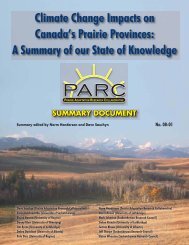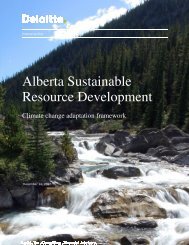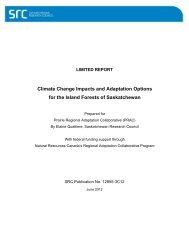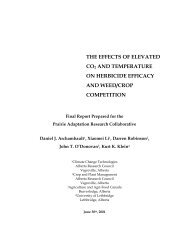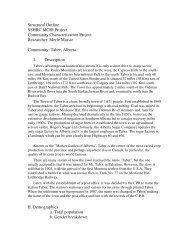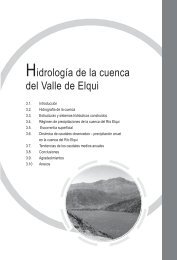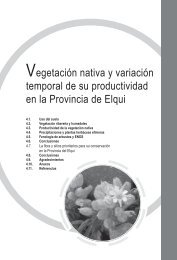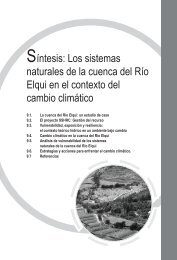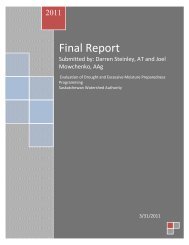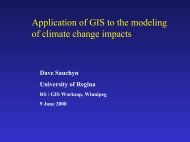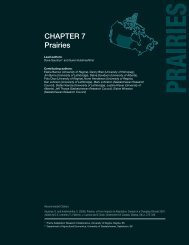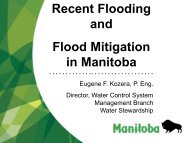Exotic Tree Species as an Adaptation Option to Climate Change in ...
Exotic Tree Species as an Adaptation Option to Climate Change in ...
Exotic Tree Species as an Adaptation Option to Climate Change in ...
You also want an ePaper? Increase the reach of your titles
YUMPU automatically turns print PDFs into web optimized ePapers that Google loves.
Policy Recommendations<br />
A number of policy recommendations have been developed<br />
<strong>as</strong> a result of the scientific literature review, the policy review,<br />
<strong>an</strong>d <strong>in</strong>put from a stakeholders workshop held after the study’s<br />
completion. The recommendations are <strong>as</strong> follows:<br />
1. The western boreal forest should be moni<strong>to</strong>red<br />
carefully for signs of systematic decl<strong>in</strong>e of native<br />
tree species aris<strong>in</strong>g from climate ch<strong>an</strong>ge or other<br />
fac<strong>to</strong>rs, <strong>as</strong> this <strong>in</strong>formation is crucial <strong>to</strong> evaluat<strong>in</strong>g<br />
the need for <strong>in</strong>troduction of exotics.<br />
2. Repl<strong>an</strong>t<strong>in</strong>g of harvested sites with seed s<strong>to</strong>ck of<br />
natives trees from sources dist<strong>an</strong>t from the pl<strong>an</strong>t<strong>in</strong>g<br />
site should be allowed, if dist<strong>an</strong>t seed sources are<br />
better adapted th<strong>an</strong> local sources <strong>to</strong> the ch<strong>an</strong>g<strong>in</strong>g<br />
climate.<br />
3. Policies for <strong>in</strong>troduction of exotic trees should vary<br />
accord<strong>in</strong>g <strong>to</strong> l<strong>an</strong>d ownership <strong>an</strong>d l<strong>an</strong>d use/ecological<br />
objectives. In protected are<strong>as</strong> that serve <strong>as</strong> ecological<br />
benchmarks, for example, exotic pl<strong>an</strong>tations should<br />
not be approved, while on prov<strong>in</strong>cial forest l<strong>an</strong>d,<br />
exotics may be acceptable <strong>in</strong> some situations.<br />
4. Individual exotic tree species should be<br />
subject <strong>to</strong> a st<strong>an</strong>dardized <strong>as</strong>sessment process<br />
<strong>to</strong> determ<strong>in</strong>e potential <strong>in</strong>v<strong>as</strong>iveness, b<strong>as</strong>ed on<br />
the recommendations made by the<br />
International Union for the Conservation<br />
of Nature (IUCN 1987). Some examples<br />
<strong>in</strong>clude:<br />
• <strong>an</strong> estimation of the probability the<br />
species will so <strong>in</strong>cre<strong>as</strong>e <strong>in</strong> numbers <strong>as</strong><br />
<strong>to</strong> cause environmental damage<br />
• <strong>an</strong> estimation of the risk of<br />
<strong>in</strong>terbreed<strong>in</strong>g with native species<br />
• a study of the risk of <strong>in</strong>troduction of<br />
dise<strong>as</strong>es <strong>an</strong>d par<strong>as</strong>ites the exotic may<br />
host<br />
• a study of all ph<strong>as</strong>es of the relev<strong>an</strong>t<br />
biological <strong>an</strong>d climatic cycle<br />
• a summary of benefits <strong>an</strong>d risks<br />
5. In addition, the <strong>as</strong>sessment should <strong>in</strong>clude<br />
<strong>an</strong>alysis of such fac<strong>to</strong>rs <strong>as</strong> the net effects<br />
on timber supply, the net effects on carbon<br />
sequestration, the effect on the fire regime,<br />
<strong>an</strong>d the potential contribution of the<br />
<strong>in</strong>troduction <strong>to</strong> ecosystem diversity <strong>an</strong>d<br />
resiliency <strong>in</strong> the face of climate ch<strong>an</strong>ge.<br />
6. Controlled pl<strong>an</strong>t<strong>in</strong>g trials, with appropriate<br />
moni<strong>to</strong>r<strong>in</strong>g <strong>an</strong>d evaluation, should precede<br />
widespread pl<strong>an</strong>t<strong>in</strong>g.<br />
7. Assessment of previous <strong>in</strong>troductions<br />
should take place; priority should be given<br />
<strong>to</strong> suspected problem species (such <strong>as</strong><br />
carag<strong>an</strong>a <strong>in</strong> the forest fr<strong>in</strong>ge) <strong>an</strong>d <strong>to</strong> trial<br />
pl<strong>an</strong>t<strong>in</strong>gs of exotics from p<strong>as</strong>t decades (<strong>to</strong><br />
exam<strong>in</strong>e survivability <strong>an</strong>d <strong>in</strong>v<strong>as</strong>iveness).<br />
Figure 12: Siberi<strong>an</strong> larch<br />
13<br />
8. Us<strong>in</strong>g the results of the above <strong>as</strong>sessments,<br />
governments should regulate which exotic tree<br />
species are acceptable for widespread pl<strong>an</strong>t<strong>in</strong>g,<br />
<strong>an</strong>d the conditions or guidel<strong>in</strong>es under which<br />
such pl<strong>an</strong>t<strong>in</strong>g could occur.<br />
9. Government should develop guidel<strong>in</strong>es for the<br />
location <strong>an</strong>d design of exotic pl<strong>an</strong>tations, aimed<br />
at m<strong>in</strong>imiz<strong>in</strong>g <strong>in</strong>v<strong>as</strong>ion risks.<br />
10. As with other developments, widespread pl<strong>an</strong>t<strong>in</strong>g<br />
of <strong>an</strong> exotic tree species should be preceded by<br />
<strong>an</strong>d subject <strong>to</strong> <strong>an</strong> environmental <strong>as</strong>sessment,<br />
<strong>in</strong>clud<strong>in</strong>g public <strong>an</strong>d stakeholder consultation.<br />
11. Federal <strong>an</strong>d prov<strong>in</strong>cial governments should<br />
jo<strong>in</strong>tly review their current policies related <strong>to</strong><br />
<strong>in</strong>troduction of exotic tree species, <strong>to</strong> determ<strong>in</strong>e<br />
whether new legislation or regulations are<br />
needed, <strong>an</strong>d <strong>to</strong> avoid duplication.<br />
12. There should be communication <strong>to</strong> stakeholders<br />
<strong>an</strong>d the public about the challenges of a ch<strong>an</strong>g<strong>in</strong>g<br />
climate <strong>to</strong> the western boreal ecosystem, <strong>an</strong>d<br />
options for adaptation.<br />
13. Governments should articulate their current<br />
policies regard<strong>in</strong>g <strong>in</strong>troduction of exotic species.




